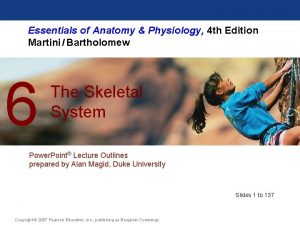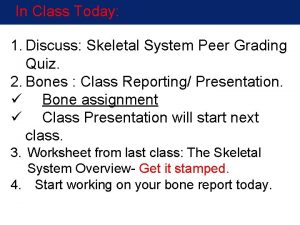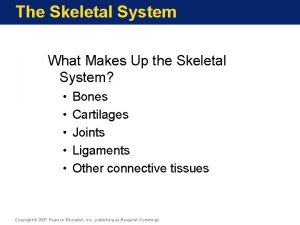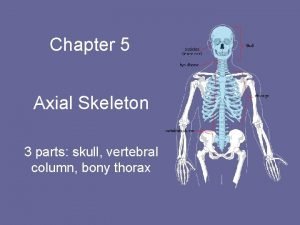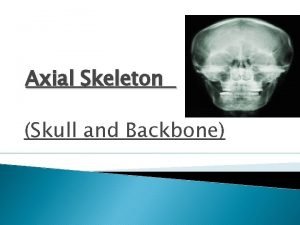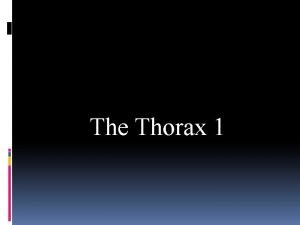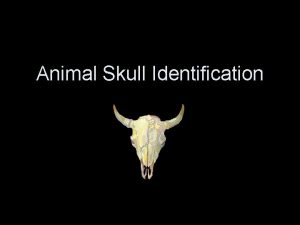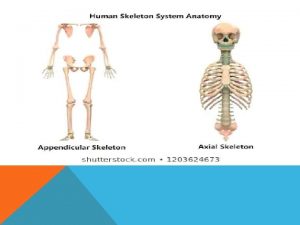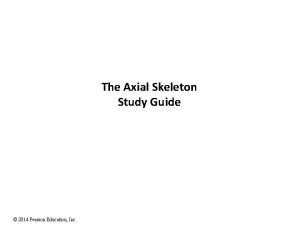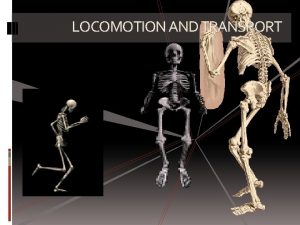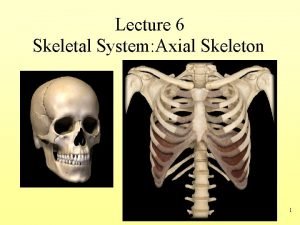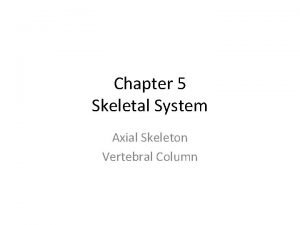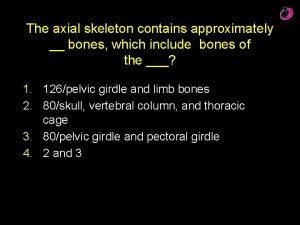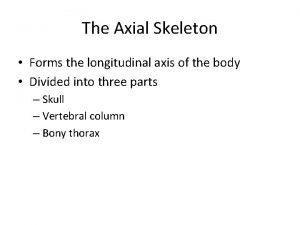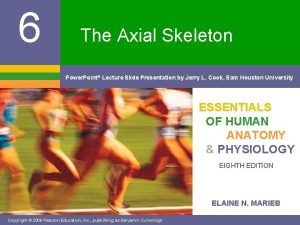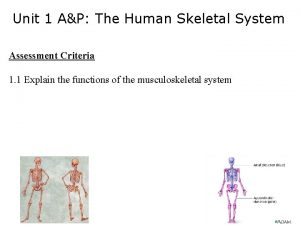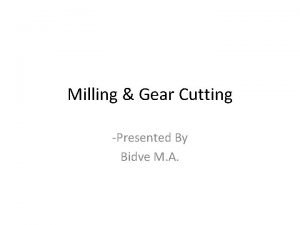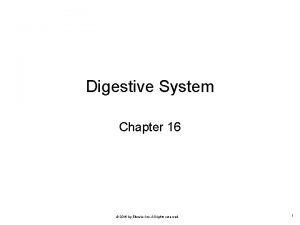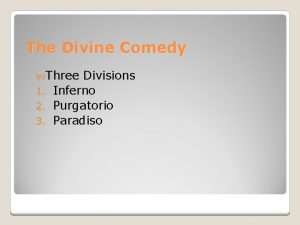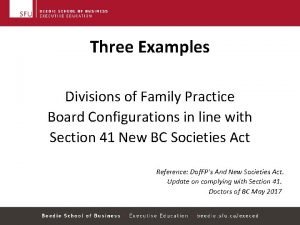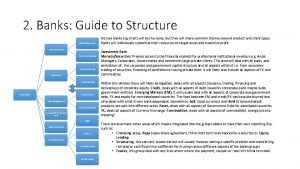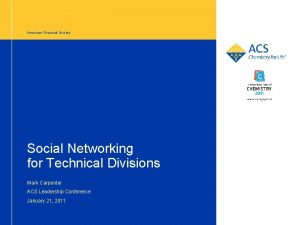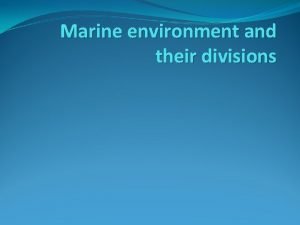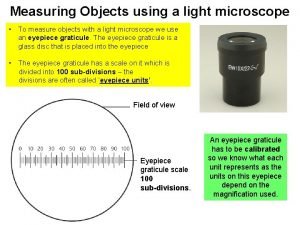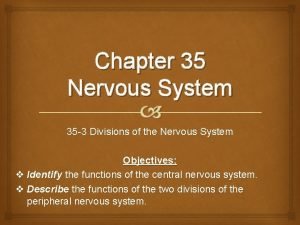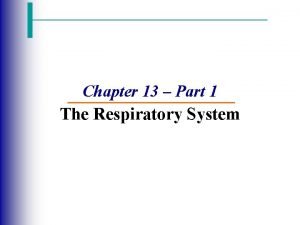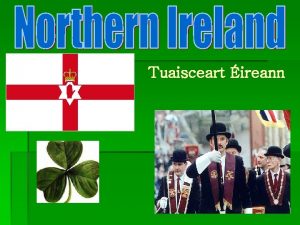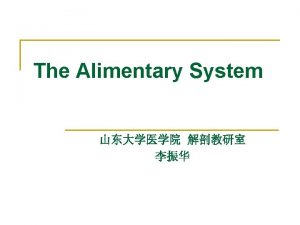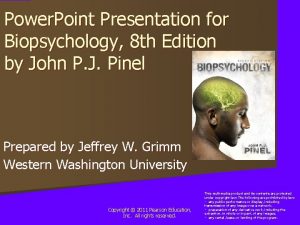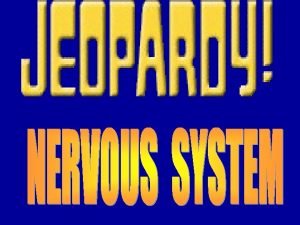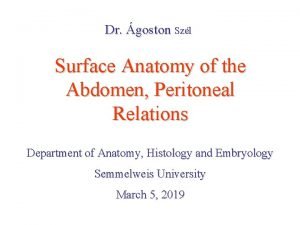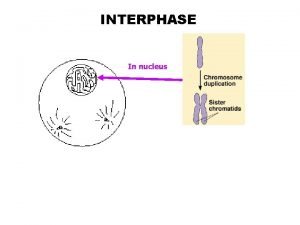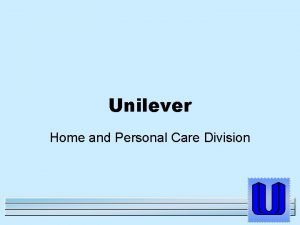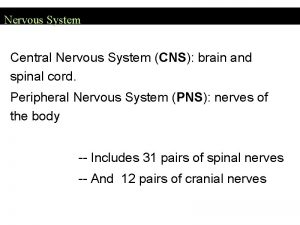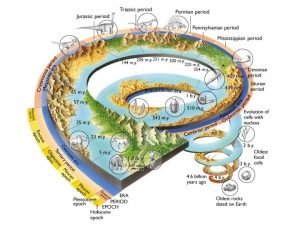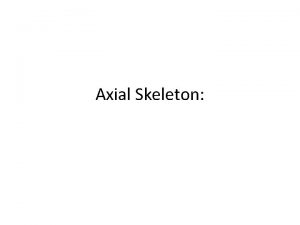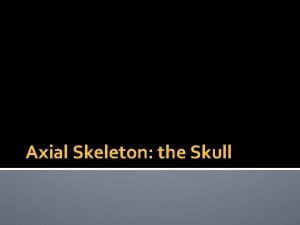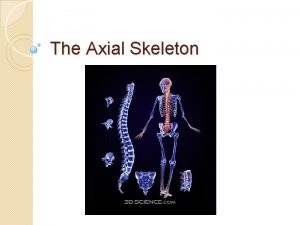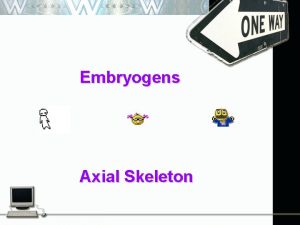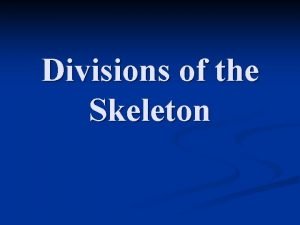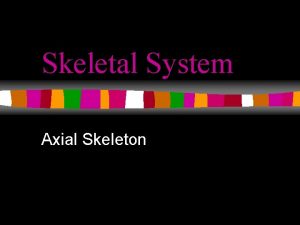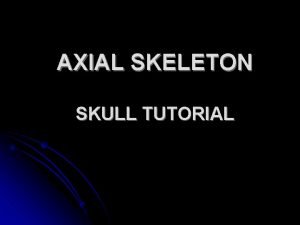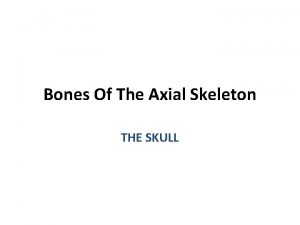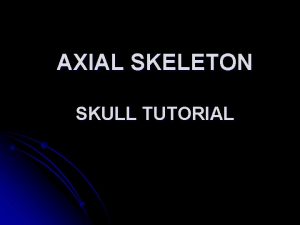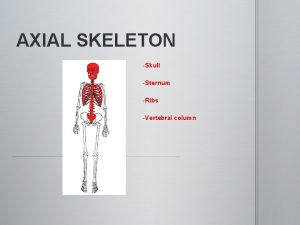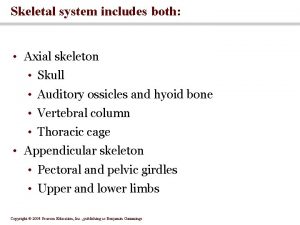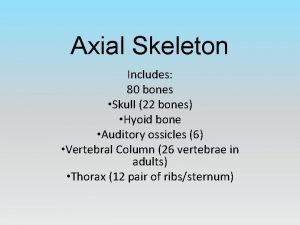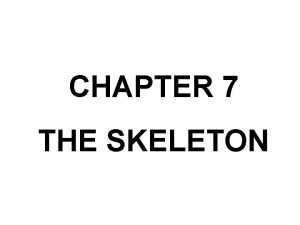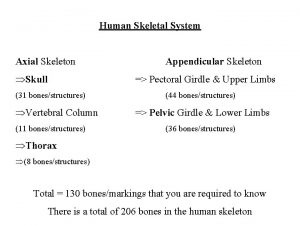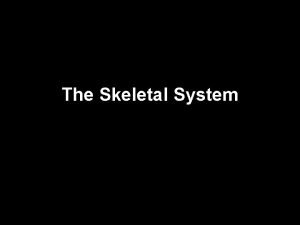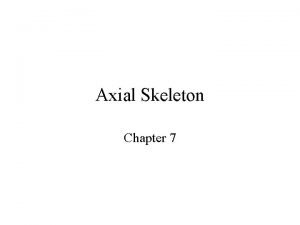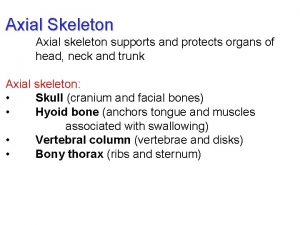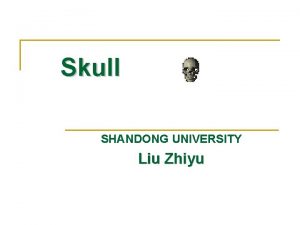Divisions of the Skeleton Axial Skeleton Includes skull

















































- Slides: 49

Divisions of the Skeleton


Axial Skeleton §Includes skull, spine, and ribs.

Skull §Made up of 22 Bones: §Facial bones = 14 §Cranium =8

CRANIUM § Bones that enclose the brain (8).

COLOR CODE § Color code letters A-L on the skull. § Sutures (a, b, c)

§ § § A. Frontal bone B. Pariatal bone (paired) C. Occipital bone D. Temporal bone (paired) E. Sphenoid (connects cranium to facial) F. Ethmoid (roof and sides of the nasal passage)

Frontal Bone § Contains 2 sinuses § Sinuses ?

Parietal § Paired (2)

Occipital

Temporal Bone §Paired (2)

Sphenoid (page 139)

Ethmoid Bone

Sutures (a, b, c) § Lines where bones meet, immovable joints.

Fontanels § Soft spots with no bones when babies are born. (Connective tissue)

Fontanels § As a fetus develops, its brain grows rapidly. The skull is growing as well but can not keep up. Fusion of the bones begins, but will complete after birth. A new born generally has 2 frontal bones, 4 occipital bones, and several sphenoid and temporal bones. These bones are held together by fontanels.

Foramen Magnum § Opening in occipital bone for spinal cord exit.

External Auditory Meatus § Opening in temporal bone for ear canals.


Styloid Process § Sharp bone projection to help anchor muscles assoc. with the tongue.

Facial §Bones NOT enclosing brains (13 immovable + 1 movable = 14).

Facial bones § G. Lacrimal (2) § H. Nasal Bone (2) § I. Zygomatic (2) Cheek bones § J. Maxilla (2) upper jaw § K. Mandible *Only movable joint in the skull.

Lacrimal (2) § Thin and scale like.

Nasal Bone (2) § Two rectangles that fuse and form the bridge of the nose.

Zygomatic Bone (2) § Cheek bones. § ‘Zygomatic Arch’ connects to the temporal bone.

Maxilla (2) § Form the floor of the nasal cavity and the roof of the oral cavity (hard palate). § Upper jaw

Mandible (only movable face bone)



OSSICLES § Bones in the ears. (Smallest bones in the body) Hammer Anvil Stirrup Mallus Incus Stapes

Hyoid § Attachment for movement of the tongue, doesn’t touch any other bones-base of the tongue


Vertebrae

Textbook Page 143 § 1. Spinous Process § 2. Articular Facet § 3. Transverse Process § 4. Vertebral foramen § 5. Body

Vertebrae (F) § Are the individual irregular bones that make up the spinal column

Intervertebral discs (D) §Made of tough cartilage

Vertebral Column § The spine is broken into 4 sections. § 1. Cervical § 2. Thoracic § 3. Lumbar § 4. a. Sacrum § b. Coccyx

CERVICAL § Total = 7 § Location = neck § #’s = C 1 -C 7

Thoracic § Total = 12 § Location = Thoracic cavity § #’s = T 1 -T 12

LUMBAR VERTEBRAE § Total = 5 § Location = Lower back § #’s = L 1 -L 5

Sacrum § 5 fused sacral discs at base of spine.

Coccyx OUCH!!!!! §Tail Bone

Sternum §Breast Bone, 3 parts

§ Manubrium (top) § Body (middle) § Xiphoid process


RIBS – 12 pairs

True- top 7 pairs, attach directly to sternum False- next 5 pairs, do not attach directly to sternum Floating- bottom 2 ribs, no connection with sternum


 Figure 6-4 the skeleton axial and appendicular divisions
Figure 6-4 the skeleton axial and appendicular divisions Figure 6-4 the skeleton axial and appendicular divisions
Figure 6-4 the skeleton axial and appendicular divisions Figure 6-4 the skeleton axial and appendicular divisions
Figure 6-4 the skeleton axial and appendicular divisions Bone remodeling
Bone remodeling Receive
Receive Axial skeleton skull chapter 5
Axial skeleton skull chapter 5 Dog axial skeleton
Dog axial skeleton Appendicular vs axial
Appendicular vs axial Axial skeleton vs appendicular skeleton
Axial skeleton vs appendicular skeleton Carnivorous skull
Carnivorous skull Labeling appendicular skeleton
Labeling appendicular skeleton Mandibular foramen
Mandibular foramen Concept map bones of the pelvic girdle
Concept map bones of the pelvic girdle Axial skeleton
Axial skeleton Chapter 5 the skeletal system vertebral column
Chapter 5 the skeletal system vertebral column Lacrimal bones
Lacrimal bones The axial skeleton contains
The axial skeleton contains The axial skeleton forms the longitudinal axis of the body
The axial skeleton forms the longitudinal axis of the body Axial skeleton vertebral column
Axial skeleton vertebral column Differentiate between axial and appendicular skeleton
Differentiate between axial and appendicular skeleton Finger bones
Finger bones Sadpam
Sadpam Plain milling can be otherwise called as
Plain milling can be otherwise called as Nasa divisions
Nasa divisions Labelled diagram of a tooth
Labelled diagram of a tooth Three divisions of comedy
Three divisions of comedy Police scotland divisions map
Police scotland divisions map Laryngeal surface of epiglottis
Laryngeal surface of epiglottis Divisions of family practice
Divisions of family practice Investment bank hierarchy
Investment bank hierarchy Division of anatomy
Division of anatomy Acs technical divisions
Acs technical divisions Oceanic divisions
Oceanic divisions Major divisions
Major divisions Electrical synapse vs chemical synapse
Electrical synapse vs chemical synapse Eyepiece graticule and stage micrometer
Eyepiece graticule and stage micrometer 35-3 divisions of the nervous system
35-3 divisions of the nervous system Hosa divisions
Hosa divisions Alveolar ducts and alveoli
Alveolar ducts and alveoli Northern ireland administrative divisions
Northern ireland administrative divisions Abdominal divisions
Abdominal divisions Area radicularis
Area radicularis Divisions of biopsychology
Divisions of biopsychology Divisions of the nervous system
Divisions of the nervous system Transpyloric plane level
Transpyloric plane level Number of divisions in mitosis
Number of divisions in mitosis Unilever home & personal care
Unilever home & personal care Label the parts of the main divisions of the nervous system
Label the parts of the main divisions of the nervous system Ajk divisions
Ajk divisions 4 divisions of geologic time
4 divisions of geologic time
